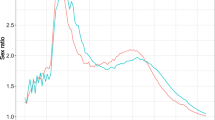Summary
Sex differences in mortality vary widely among the developed countries. Male overmortality is highest in Finland and the USSR, followed closely by France, Poland, the USA and Canada. The differential is lowest in Japan, Ireland and in south-eastern Europe. The sex mortality ratio is highest at ages 15–24 years with a second peak generally occurring around age 60. The excess mortality of males at the younger ages is due largely to motor vehicle accidents while higher death rates from heart diseases and lung cancer in particular account for a substantial proportion of male excess mortality during the later years of working life. During the course of the 20th century, the impact of sex differences in mortality from the infectious and parasitic diseases has declined, as has the contribution from maternal mortality. Males have also benefited from a decline in industrial accidents but this has been more than countered by rising death rates from heart diseases, lung cancer and motor vehicle accidents.
Résumé
Les différences de mortalité entre les sexes varient largement entre les pays développés. La surmortalité masculine est la plus élevée en Finlande et en URSS, suivis de près par la France, la Pologne, les Etats-Unis et le Canada; les différences les plus basses sont observées au Japon, en Irlande et dans le Sud-Est de l'Europe. Le différentiel de la mortalité selon le sexe est le plus élevé entre 15 et 24 ans, avec un second pic s'observant autour de l'âge de 60 ans. L'excès de mortalité chez les hommes jeunes est principalement dû aux accidents de circulation, alors que les cardiopathies et le cancer pulmonaire sont principalement responsables de la surmortalité masculine observée à la fin de la période d'activité professionnelle. Durant le 20e siècle, l'impact des différences de mortalité dû aux maladies infectieuses et parasitaires a baissé, ainsi que la contribution due à la mortalité maternelle. Les hommes ont profité d'une diminution des accidents dans le milieu de travail, mais ceci a été plus que contrebalancé par une augmentation des taux de mortalité par cardiopathies, cancer pulmonaire et accidents de véhicules à moteur.
Zusammenfassung
Die Geschlechtsunterschiede in der Sterblichkeit variieren stark zwischen den entwickelten Ländern. Die männliche Uebersterblichkeit ist am höchsten in Finnland und der UdSSR, gefolgt von Frankreich, Polen, den Vereinigten Staate und Kanada. Die kleinsten Unterschiede werden in Japan, Irland und im Süd-Osten Europas beobachtet. Die Unterschiede in der Sterblichkeit nach Geschlecht sind am höchsten zwischen 15 und 24 Jahren, mit einer zweiten Spitze um das 60. Altersjahr. Die Uebersterblichkeit bei den jungen Männern wird durch Verkehrsunfalle erklärt, während die Kardiopathien und der Lungenkrebs für die männliche Uebersterblichkeit am Ende der berufliche Periode verantwortlich sind. In diesem Jahrhundert haben sich die Einflüsse der infektiösen und parasitären Krankheiten verkleinert, gleichermassen wie die Bedeutung der Müttersterblichkeit. Die Männer haben von einer Senkung der Sterblichkeit durch Berufsunfälle profitiert, was jedoch mehr als kompensiert wird durch eine Zunahme der Sterblichkeit durch Kardiopathien, Lungenkrebs und Verkehrsunfalle.
Similar content being viewed by others
References
Lopez A. D. The sex mortality differential in developed countries. In Lopez A D and Ruzicka L T (eds.),Sex Differentials in Mortality: Trends, Determinants an Consequences. Canberra: Department of Demography, The Australian National University, 1983: 53–120.
Lopez A. D. and Ruzicka L. T. The differential mortality of the sexes in Australia. In McGlashan N D (ed.),Studies in Australian Mortality. Hobart: University of Tasmania, Environmental Studies Occasional Papers No. 4, 1977: 75–94.
Retherford R. D.The Changing Sex Differential in Mortality. Westport, Connecticut: Greenwood Press. 1975.
Author information
Authors and Affiliations
Additional information
The views expressed in this paper are those of the author and do not necessarily reflect the opinions or policies of the World Health Organization.
Rights and permissions
About this article
Cite this article
Lopez, A.D. Using national mortality data to study the changing sex differential in mortality. Soz Präventivmed 29, 258–264 (1984). https://doi.org/10.1007/BF02078261
Published:
Issue Date:
DOI: https://doi.org/10.1007/BF02078261




